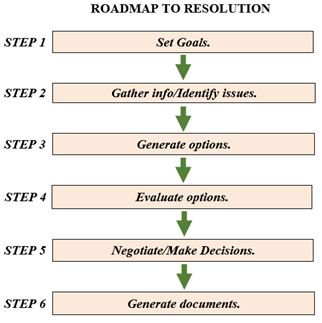The viral video of a father reaching out to his ex-Wife’s new husband, his daughter’s stepdad, and asking him to join him and walk their daughter down the aisle has had a huge impact. It has been shared millions of times.
I have noticed a number of my social media friends and colleagues sharing this video. The comments seem to fall into two categories. First, for divorced parents or children of divorce, many look at this video as a painful reminder of how horrible divorce can be. Many have memories of the strain and tension between their parents after divorce or cannot imagine ever having a connection with an exes new partner.
Others see this video as recognition of the new face of divorce. Divorce can be healthy and can lead to new families that are, in many ways, stronger and healthier than they were before. Bonus parents or step parents can be wonderful additions to a child’s life.
I see these stories all the time. I am a collaborative attorney dedicated to helping families divorce in better ways. I hear stories of clients all the time having better relationships with their co-parent after a divorce. Like this mother who wrote a letter to her daughter’s future step-mother or this lovely New York Times article about two divorced parents vacationing together — this can be the new face of divorce.
The collaborative law process allows for creative and respectful outcomes – it keeps the children at the very center of everything and helps families thrive. Social media is drawn to thee stories because people crave these types of outcomes and want a better future after divorce. Collaborative law provides these types of resolutions and more and more peaceful extended families.
 Married, separated, or divorced alike, it’s hard not to feel anxious about the upcoming holiday season. Whether you love it or are dreading it, the 2015 holiday season is just around the corner. Maybe you are feeling that there is no way you are going to get through this year with your emotions in check. You are not alone. Whether you are feeling anger, sadness, grief, frustration, anxiety, etc. it is important to feel balance this time of year. How do you do that, especially if you are still grieving from your divorce?
We can’t (and shouldn’t) try to banish these emotions. However, we can be intentional and generate positive emotions to help redistribute the weight of these negative emotions. So how can you do that even if you are feeling completely down this time of year? We’ve blogged previously about ways of helping others and paying it forward as ways to help ourselves emotionally, and ‘tis the season of a vast array of opportunities to help others, but here are some additional ideas for creating positive emotions in your world:
Finding Nature: Nature has an amazing way of soothing us without words. Sit down and make a list of places nearby to visit nature. Maybe some are as easy as stepping out your front door and others maybe involve a little bit of a drive. Even that drive to get their can prove to be therapeutic. Nature heals and being in nature, or even viewing scenes of nature, has been shown to reduces anger, fear, and stress.
Exercise: It’s no secret that exercise can help to balance your emotions – whether it’s running, walking, yoga, or even a team sport, find what you love and carve time out of your schedule to do it! When you exercise, the body releases endorphins that minimize the sensation of pain. These endorphins elevate your mood and reduce feelings of anxiety. You will also feel better when you exercise and because you are healthier, you will have more energy, and feel more balanced.
Distractions: Distractions can be a positive solution for balancing emotions. Although you might be thinking that distractions will just bury your feelings to come out later on, healthy distractions provide positive emotions that will help you to release some of the negative feelings. Make a list of both healthy and unhealthy distractions that you tend to gravitate towards. While an unhealthy distraction like having drinks with friends seems like a good idea in the moment, a healthy distraction like Saturday morning coffee with a friend will prove to be better for your emotions.
Focus on the Positive: Right now you might be thinking, “what positive?” At Daisy Camp we love the quote, “There is always, ALWAYS, something to be thankful for.” Maybe you’ve found journaling a helpful process for you through your divorce, which is great, but if you read through it, it may bring on raw and deep negative emotions, so start a separate gratitude journal. Make lists of what you are thankful for (past, present, and future), and try to add to that list daily. When you are feeling down – read that journal.
Wishing you strength and positivity as you balance your emotions this holiday season. Remember that, “Nothing can dim the light that shines from within.” Maya Angelou. You will make it through this.
Married, separated, or divorced alike, it’s hard not to feel anxious about the upcoming holiday season. Whether you love it or are dreading it, the 2015 holiday season is just around the corner. Maybe you are feeling that there is no way you are going to get through this year with your emotions in check. You are not alone. Whether you are feeling anger, sadness, grief, frustration, anxiety, etc. it is important to feel balance this time of year. How do you do that, especially if you are still grieving from your divorce?
We can’t (and shouldn’t) try to banish these emotions. However, we can be intentional and generate positive emotions to help redistribute the weight of these negative emotions. So how can you do that even if you are feeling completely down this time of year? We’ve blogged previously about ways of helping others and paying it forward as ways to help ourselves emotionally, and ‘tis the season of a vast array of opportunities to help others, but here are some additional ideas for creating positive emotions in your world:
Finding Nature: Nature has an amazing way of soothing us without words. Sit down and make a list of places nearby to visit nature. Maybe some are as easy as stepping out your front door and others maybe involve a little bit of a drive. Even that drive to get their can prove to be therapeutic. Nature heals and being in nature, or even viewing scenes of nature, has been shown to reduces anger, fear, and stress.
Exercise: It’s no secret that exercise can help to balance your emotions – whether it’s running, walking, yoga, or even a team sport, find what you love and carve time out of your schedule to do it! When you exercise, the body releases endorphins that minimize the sensation of pain. These endorphins elevate your mood and reduce feelings of anxiety. You will also feel better when you exercise and because you are healthier, you will have more energy, and feel more balanced.
Distractions: Distractions can be a positive solution for balancing emotions. Although you might be thinking that distractions will just bury your feelings to come out later on, healthy distractions provide positive emotions that will help you to release some of the negative feelings. Make a list of both healthy and unhealthy distractions that you tend to gravitate towards. While an unhealthy distraction like having drinks with friends seems like a good idea in the moment, a healthy distraction like Saturday morning coffee with a friend will prove to be better for your emotions.
Focus on the Positive: Right now you might be thinking, “what positive?” At Daisy Camp we love the quote, “There is always, ALWAYS, something to be thankful for.” Maybe you’ve found journaling a helpful process for you through your divorce, which is great, but if you read through it, it may bring on raw and deep negative emotions, so start a separate gratitude journal. Make lists of what you are thankful for (past, present, and future), and try to add to that list daily. When you are feeling down – read that journal.
Wishing you strength and positivity as you balance your emotions this holiday season. Remember that, “Nothing can dim the light that shines from within.” Maya Angelou. You will make it through this.  An amicable separation and divorce can sometimes become strained when new relationships start. New significant others often cause new emotional reactions that can subsequently impact parenting. In order to preemptively address the problems that can arise when new relationships start, in collaborative divorce, we often come up with parameters to address significant others.
Here are some potential options to consider when thinking about agreements on significant others. Any or all may be included in a parenting plan.
An amicable separation and divorce can sometimes become strained when new relationships start. New significant others often cause new emotional reactions that can subsequently impact parenting. In order to preemptively address the problems that can arise when new relationships start, in collaborative divorce, we often come up with parameters to address significant others.
Here are some potential options to consider when thinking about agreements on significant others. Any or all may be included in a parenting plan.
- One option is to not allow the children to be introduced to any significant others without agreement of the other parent.
- Sometimes parents like to have a period of time (such as six months or one year) after the divorce is final when no significant other shall be introduced to the children.
- An introduction to a significant other may only occur when a neutral parenting expert (such as a child specialist in the collaborative divorce process) recommends that it is appropriate to do so.
- Parents often keep some aspirational language in the decree such as: “Both parents understand that it is in the best interest of the children to support the children’s relationship with any long-term significant other of the other parent and shall make all reasonable efforts to do so.”
 Often when we decide to do something of significance, like go on vacation, obtain a college degree, search for a new job, or save for a future purchase we develop a plan. If you are serious about the task set before you, you will develop a written plan to keep you on track and measure your progress.
Getting unmarried, as I now refer to divorce, should be no different. In fact, if you choose to use a collaborative divorce process, we utilize a written document called “Roadmap to Resolution.” I have found the use of this Roadmap extends beyond divorce planning. I use it as a general problem-solving model. The Roadmap has 6 essential steps.
Often when we decide to do something of significance, like go on vacation, obtain a college degree, search for a new job, or save for a future purchase we develop a plan. If you are serious about the task set before you, you will develop a written plan to keep you on track and measure your progress.
Getting unmarried, as I now refer to divorce, should be no different. In fact, if you choose to use a collaborative divorce process, we utilize a written document called “Roadmap to Resolution.” I have found the use of this Roadmap extends beyond divorce planning. I use it as a general problem-solving model. The Roadmap has 6 essential steps.
- Set Goals The four basic sets of big picture goals include: Relationship goals between you and your soon to be ex-spouse Goals related to your children regardless of their ages Financial goals as to how you and your spouse would like your future financial lives to look so you both can have the greatest sense of financial well being with the resources you have Process goals as to how you and your spouse would like the process to work for you
- Gather Information and Identify Issues This includes gathering all financial documents and other relevant information that will be necessary to itemize all assets, liabilities, income, estimated reasonable and necessary living expenses, and property received as a gift, inherited, or acquired before the marriage. All of this information is documented in your final divorce decree. If you have children, this also includes information about your children their needs and special activities and costs associated with each one.
- Generate Options This step is when the collaborative team including attorneys, coach, child specialist, financial neutral, and clients brainstorm to identify any options that come to mind regardless of how silly or unpleasant those options might sound initially. The key is to write down as many options as possible without anyone commenting or trying to evaluate any stated options.
- Evaluate Options Here the clients indentify the options they would like to evaluate and consider. It is at this stage clients can fully explore the pros and cons of each of the options listed and prioritize them.
- Negotiate/Make Decisions After fully evaluating any options clients are able to negotiate and make decisions they both can live with.
- Generate Documents Once all necessary decisions are made, the attorneys go to work to document agreements by preparing a draft decree for each spouse to review and ultimately sign.
 Vacations are a common part of family life. Some families like to camp or take close-to-home trips to a local hotel or amusement location. Other families have vacation traditions, such as family reunions or a favorite locales that they visit year after year. And others may like to spend freely and take extravagant vacations.
It is common to be concerned about vacations in divorce. When one, nuclear family becomes a bi-nuclear family with two home bases, it may seem like a foregone conclusion that vacations will need to end. While things certainly need to change, in a collaborative divorce, parents can work to develop a parenting plan that incorporates vacations and time away with the kids.
It is common in parenting plans to provide each parent a certain number of days to take the children on vacation. This time typically supersedes regular parenting plan – it is not a trade-off of days. The parenting plan can outline further parameters on vacations, such as:
Vacations are a common part of family life. Some families like to camp or take close-to-home trips to a local hotel or amusement location. Other families have vacation traditions, such as family reunions or a favorite locales that they visit year after year. And others may like to spend freely and take extravagant vacations.
It is common to be concerned about vacations in divorce. When one, nuclear family becomes a bi-nuclear family with two home bases, it may seem like a foregone conclusion that vacations will need to end. While things certainly need to change, in a collaborative divorce, parents can work to develop a parenting plan that incorporates vacations and time away with the kids.
It is common in parenting plans to provide each parent a certain number of days to take the children on vacation. This time typically supersedes regular parenting plan – it is not a trade-off of days. The parenting plan can outline further parameters on vacations, such as:
- How much notice should be given for an upcoming trip.
- Whether or not vacations can incorporate missing school.
- Number of consecutive days allowed.
- Communication parameters between the off-duty parent and the children while on vacation.
- How far the children may be taken and what activities are permissible.
 Looking for some Twin Cities fun on a budget? Going from a duel income to a single income is not only difficult, but can bring on many emotions, especially if it leaves you feeling inadequate with providing for your children. There are so many low and no cost options out there that you don’t have to feel your children are missing out if you are on a single parent budget. Here are some of our favorites:
Looking for some Twin Cities fun on a budget? Going from a duel income to a single income is not only difficult, but can bring on many emotions, especially if it leaves you feeling inadequate with providing for your children. There are so many low and no cost options out there that you don’t have to feel your children are missing out if you are on a single parent budget. Here are some of our favorites:
- Como Zoo (free)
- Minneapolis Sculpture Garden (free)
- Walker Art Center (free admission Thursdays from 5-9pm)
- Minnesota History Center (free admission Tuesdays from 5-8pm)
- Fishing at many local community piers and parks (free)
- Minnehaha Falls (free)
- Three Rivers Parks District: Elm Creek Park Reserve, Lowery nature Center, Minnetonka Regional Park, etc. (free admission and many free activities and play equipment). Tip: make a list for a scavenger hunt before you go, kids LOVE scavenger hunts!
- Minnesota Children’s Museum (free admission the 3rd Sunday of each month)
- Outdoor concerts in the summer: Minneapolis Music in the Parks and St. Paul Music in the Parks, as well as many suburban concert series (free)
- Movies in the Park in Summer: many area options (free)
- Minnesota Landscape Arboretum (free admission every third Thursday of the month after 4:30 pm April through October)
- Farmer’s Markets: many area options, check your city and surrounding areas for dates and times. Tip: If you go close to the end of the day many vendors may have reduced their prices or are willing to negotiate on fresh produce. (free admission)
- Bike or walk the area trails. We are very blessed with many quality area trails like the Luce Line, Dakota Rail Regional Trail, etc. Tip: Another great place for a scavenger hunt!
- Local beaches in the summer – We are in the land of 10,000 lakes, there are so many options for free swimming and sand castle fun!
- Local art fairs, craft fairs, car shows, etc. Admission is typically free and it is so fun to walk around and look at everything.
Your divorce probably has you feeling like everything is beyond your control. Now imagine the lack of control your children are feeling. Yesterday they had a family with two parents living under the same roof, and today their family life as they knew it is torn apart. Your children may not have any idea how things got to this point, much less have the ability to change things. While it is seemingly impossible to feel in control right now, as a parent it is your role to support your children and help them to cope with the stress of the divorce. Focusing on these four components should help to lessen the stress on your children: patience, reassurance, structure, and stability.
Patience. Have the patience to answer your child’s never ending questions they may have about the divorce. Offer them a listening ear and time to vent. Patience is tricky, especially when you are going through such a stressful time in your life. This is why it becomes so incredibly important for you to take care of yourself so that you can be the best parent you can be. Do whatever you can not to take your own stress out on your children. Even if it’s as simple as locking yourself in the bathroom for 5 minutes to cool off – do it.
Reassurance. Reassure your children that they are still loved by both parents, and that they did not cause this. Reassure them that it is ok to have fun and enjoy their time with each parent by not acting jealous or getting upset. Do not put your child in a situation where they are forced to pick a side, which will only cause them more stress. Reassure them that you will get through this together, and that this is not the end of their family, but rather the beginning of a different type of family for them.
Structure. By providing routines kids can rely on, you remind your children they can count on you for stability, structure, and care. This is where parenting plans come into play and are so important to maintaining structure. A toddler may not know what day of the week it is, but something as simple as a color coded weekly calendar showing them what days they go to moms house at what days they go to dads house can help them to understand their routine. A preteen or teen may benefit more from an electronic calendar, where they know exactly who is picking them up from school and activities each day. Find what works best for maintaining structure in your family and stick to it.
Stability. It is important to maintain structure in order to provide stability for your children. If one parent has bailed on picking up the kids for the past two weeks, that child no longer has the stability in their life to help them cope with the stress of divorce. Parents in this situation will often stop telling their children when the other parent is going to pick them up because they hate to see them get disappointed. When this happens the parenting plan needs to be addressed and reevaluated. Not only is it stressful on the parent when the other doesn’t follow through, but it is incredibly stressful on children.
All of these points go hand in hand with one another. The more stability and structure you have, the more reassured your child will be. Divorce may be uncharted territory, but you can successfully navigate this unsettling time—and help your kids emerge from it feeling loved, confident, and strong.
 We are currently enjoying the annual Minnesota Get-Together. The State Fair is an annual ritualistic event that many Minnesotans appreciate. When families are divorcing, it is often important to continue to maintain these rituals to keep consistency for children. When conflict overwhelms a divorce these important factors may be lost. A collaborative process, that focuses on the interests of the parties can help keep these important rituals in the family.
Many families take the annual trek to St. Paul, Minnesota to the State Fair grounds. Whether they drive and pay $20 to park on someone’s lawn or jump in a church parking lot and take a free shuttle, they all end up at the Fair. Once there, they may play games in the Midway, taste meatloaf on a stick or Sweet Martha’s Cookies, or explore the many educational/agricultural opportunities. There are parades and musical performances. Animals galore. It seems everyone has their own “way” of exploring the Fair.
When a family divorces, the annual Fair-going event may change. Some families can maintain the traditions and attend the fair together, despite the new status of divorce. Other families may trade-off the Fair event each year or share it in some way (mom and dad swap at the corner of Cosgrove and Randall). Or maybe a family friend or grandparent will maintain the tradition.
What is most unfortunate, however, is when these types of traditions are lost altogether. It may result from financial challenges or anger between the parents. Sometimes rituals are just lost in the transitions – they may be forgotten. A collaborative process can help to keep the focus of divorce on the children. Keeping the focus on what matters most to them will help keep these types of rituals in the forefront. As a whole, the family will be better off and rituals can be maintained if you work together on the outcomes.
We are currently enjoying the annual Minnesota Get-Together. The State Fair is an annual ritualistic event that many Minnesotans appreciate. When families are divorcing, it is often important to continue to maintain these rituals to keep consistency for children. When conflict overwhelms a divorce these important factors may be lost. A collaborative process, that focuses on the interests of the parties can help keep these important rituals in the family.
Many families take the annual trek to St. Paul, Minnesota to the State Fair grounds. Whether they drive and pay $20 to park on someone’s lawn or jump in a church parking lot and take a free shuttle, they all end up at the Fair. Once there, they may play games in the Midway, taste meatloaf on a stick or Sweet Martha’s Cookies, or explore the many educational/agricultural opportunities. There are parades and musical performances. Animals galore. It seems everyone has their own “way” of exploring the Fair.
When a family divorces, the annual Fair-going event may change. Some families can maintain the traditions and attend the fair together, despite the new status of divorce. Other families may trade-off the Fair event each year or share it in some way (mom and dad swap at the corner of Cosgrove and Randall). Or maybe a family friend or grandparent will maintain the tradition.
What is most unfortunate, however, is when these types of traditions are lost altogether. It may result from financial challenges or anger between the parents. Sometimes rituals are just lost in the transitions – they may be forgotten. A collaborative process can help to keep the focus of divorce on the children. Keeping the focus on what matters most to them will help keep these types of rituals in the forefront. As a whole, the family will be better off and rituals can be maintained if you work together on the outcomes.  Now that everyone is back to school, here are some important things to remember for divorced families:
1. Be Mindful of the Schedule. Parents often look forward to the routine and structure of school, that is often lost in the summer months. Kids need that same sort of structure. Depending on the age of the children, help keep them apprised of the schedule with an online-scheduler or written calendar. Remember that changes to a schedule affect everyone – so be mindful of how adjustments will be accepted by everyone. You have to balance flexibility and adaptability.
2. Stock up on School Supplies. Kids often display anxiety with the need to remember clothes, school supplies, or materials for extra curricular activities (sports equipment, musical instruments, school supplies, etc.). Make sure both houses are stocked up or the kids have a good routine (with parent support) to make sure they have everything they need at both homes.
3. Start Communicating. There are so many elements of children’s daily lives that they are interested in sharing after a busy day at school. And then the school often communicates with parents via emails or handouts. Sometimes things are learned during school pick-up or by talking to another parent. This information should be shared — come up with a routine for sharing relevant information about the kids so that both parents are fully informed. Daily emails or texts are often an easy way to keep the off duty parent informed.
4. Plan for Homework and Activities. Kids often have full schedules afters school. Between homework and extra-curricular activities, many parents feel as if their after school hours are as busy as their work days. Together with the children come up with a plan to manage the responsibilities every day. It is okay to have different schedules at each home, but consider coordinating efforts or sharing your plan so both homes can best support the children.
5. Plan for Downtime. Life gets busy. Make effort to find time for fun and relaxation as the busy life of school starts up. Everyone deserves a break – so plan for a game night or go see a movie. You will all appreciate a little downtime.
Now that everyone is back to school, here are some important things to remember for divorced families:
1. Be Mindful of the Schedule. Parents often look forward to the routine and structure of school, that is often lost in the summer months. Kids need that same sort of structure. Depending on the age of the children, help keep them apprised of the schedule with an online-scheduler or written calendar. Remember that changes to a schedule affect everyone – so be mindful of how adjustments will be accepted by everyone. You have to balance flexibility and adaptability.
2. Stock up on School Supplies. Kids often display anxiety with the need to remember clothes, school supplies, or materials for extra curricular activities (sports equipment, musical instruments, school supplies, etc.). Make sure both houses are stocked up or the kids have a good routine (with parent support) to make sure they have everything they need at both homes.
3. Start Communicating. There are so many elements of children’s daily lives that they are interested in sharing after a busy day at school. And then the school often communicates with parents via emails or handouts. Sometimes things are learned during school pick-up or by talking to another parent. This information should be shared — come up with a routine for sharing relevant information about the kids so that both parents are fully informed. Daily emails or texts are often an easy way to keep the off duty parent informed.
4. Plan for Homework and Activities. Kids often have full schedules afters school. Between homework and extra-curricular activities, many parents feel as if their after school hours are as busy as their work days. Together with the children come up with a plan to manage the responsibilities every day. It is okay to have different schedules at each home, but consider coordinating efforts or sharing your plan so both homes can best support the children.
5. Plan for Downtime. Life gets busy. Make effort to find time for fun and relaxation as the busy life of school starts up. Everyone deserves a break – so plan for a game night or go see a movie. You will all appreciate a little downtime.
 In his book about how to avoid human conflict, Don Miguel Ruiz suggests these four agreements that a person makes with himself or herself:
1. I will be impeccable with my word.
2. I will not personalize the anything the other person says, does, feels, thinks or believes.
3. I will make no assumptions.
4. I will do my best each day with the energy I have been given.
This post will focus on the Third Agreement, which can be very difficult to keep, in part because of how we are wired. Our human brains are constantly analyzing our environment and making conscious and subconscious decisions about whether or not a threat exists. Without this vigilance, we would not have survived as a species. Our vigilant human brains are also designed to categorize and sort, and then to recognize patterns. When patterns repeat, we give the patterns a meaning and define this as learning. This is how our brains are designed to work.
However, it can happen that when we recognize patterns, we give them the wrong meaning. We can make an incorrect assumption (which is the definition of a superstition). We get further and further from real meaning if we persist in believing and acting on our assumptions. This can create unnecessary misunderstanding and conflict, and it happens all the time, especially in intimate relationships. Rather than make assumptions, it is important to remain open to alternate interpretations and ask good questions.
One can easily make misguided assumptions even when absolutely sure one is right. When I met my mother-in-law, her home was filled with frog ornaments. For years, family members gave her frog-themed items for her birthday and Christmas, and she found places to display them all. After 10 years, I happened to ask her when she first started to like frogs. She responded, “Oh, I don’t like frogs.” All evidence to the contrary! I said in puzzlement, “But you have such a collection of frogs, I just assumed you liked them.” She smiled and told about receiving frog-decorated towels as a thank you gift from a guest. She put the towels in her guest bathroom, and the next guests assumed she liked frogs and bought her a frog ornament, which she promptly displayed. What was never true about my wonderful mother-in-law was that she liked frogs. What was true was that she proudly displayed the gifts she was given, to honor the givers.
In the relationship crisis of a divorce or break up, it can be especially easy to make negative assumptions about one’s spouse or partner, and express these assumptions directly to other people. A child once told me in tears about hearing one parent say to the other, “This divorce is proof you never really loved your family.” Making the Third Agreement helps ensure that children will be kept at the center and out of the middle.
In his book about how to avoid human conflict, Don Miguel Ruiz suggests these four agreements that a person makes with himself or herself:
1. I will be impeccable with my word.
2. I will not personalize the anything the other person says, does, feels, thinks or believes.
3. I will make no assumptions.
4. I will do my best each day with the energy I have been given.
This post will focus on the Third Agreement, which can be very difficult to keep, in part because of how we are wired. Our human brains are constantly analyzing our environment and making conscious and subconscious decisions about whether or not a threat exists. Without this vigilance, we would not have survived as a species. Our vigilant human brains are also designed to categorize and sort, and then to recognize patterns. When patterns repeat, we give the patterns a meaning and define this as learning. This is how our brains are designed to work.
However, it can happen that when we recognize patterns, we give them the wrong meaning. We can make an incorrect assumption (which is the definition of a superstition). We get further and further from real meaning if we persist in believing and acting on our assumptions. This can create unnecessary misunderstanding and conflict, and it happens all the time, especially in intimate relationships. Rather than make assumptions, it is important to remain open to alternate interpretations and ask good questions.
One can easily make misguided assumptions even when absolutely sure one is right. When I met my mother-in-law, her home was filled with frog ornaments. For years, family members gave her frog-themed items for her birthday and Christmas, and she found places to display them all. After 10 years, I happened to ask her when she first started to like frogs. She responded, “Oh, I don’t like frogs.” All evidence to the contrary! I said in puzzlement, “But you have such a collection of frogs, I just assumed you liked them.” She smiled and told about receiving frog-decorated towels as a thank you gift from a guest. She put the towels in her guest bathroom, and the next guests assumed she liked frogs and bought her a frog ornament, which she promptly displayed. What was never true about my wonderful mother-in-law was that she liked frogs. What was true was that she proudly displayed the gifts she was given, to honor the givers.
In the relationship crisis of a divorce or break up, it can be especially easy to make negative assumptions about one’s spouse or partner, and express these assumptions directly to other people. A child once told me in tears about hearing one parent say to the other, “This divorce is proof you never really loved your family.” Making the Third Agreement helps ensure that children will be kept at the center and out of the middle.

